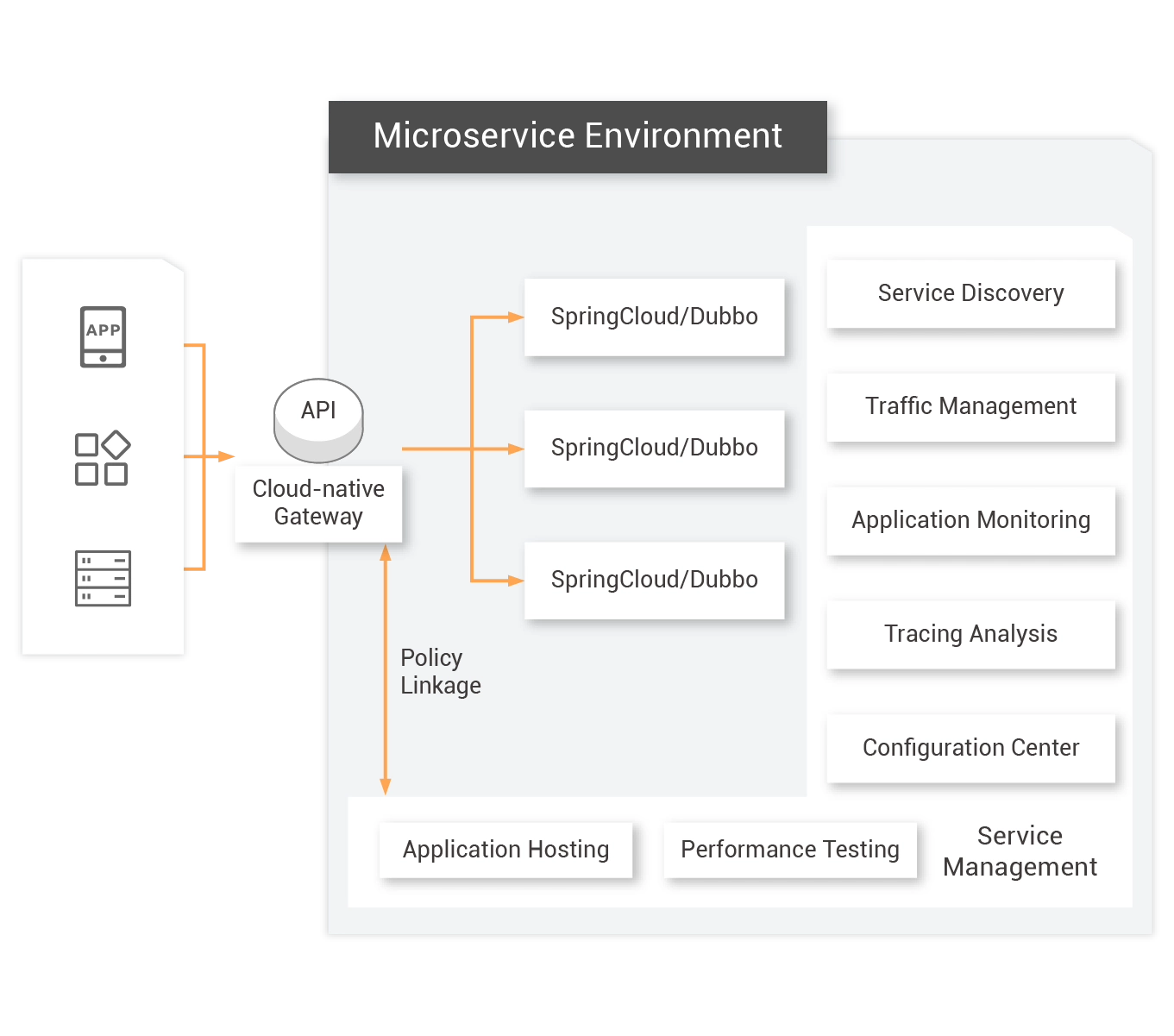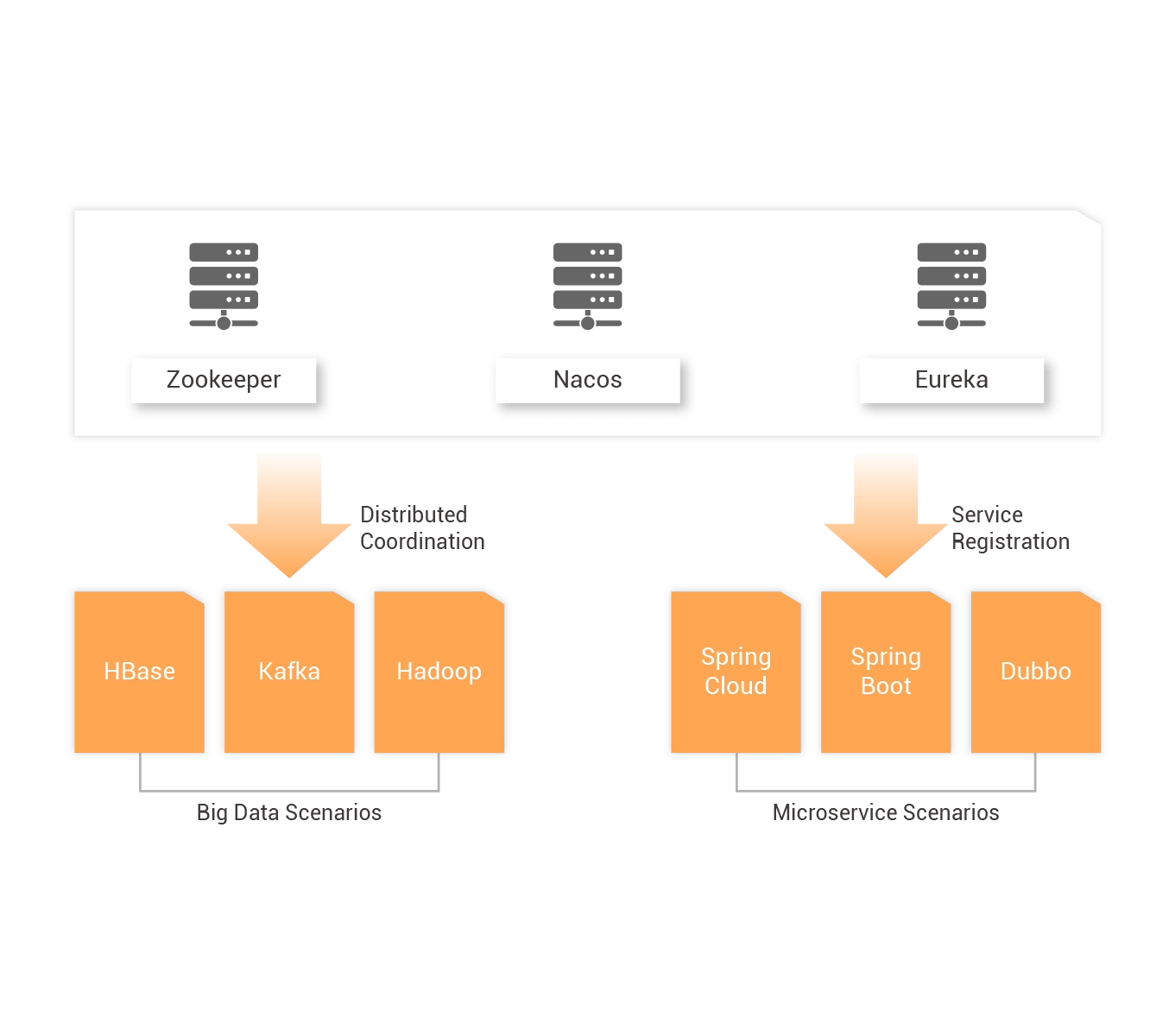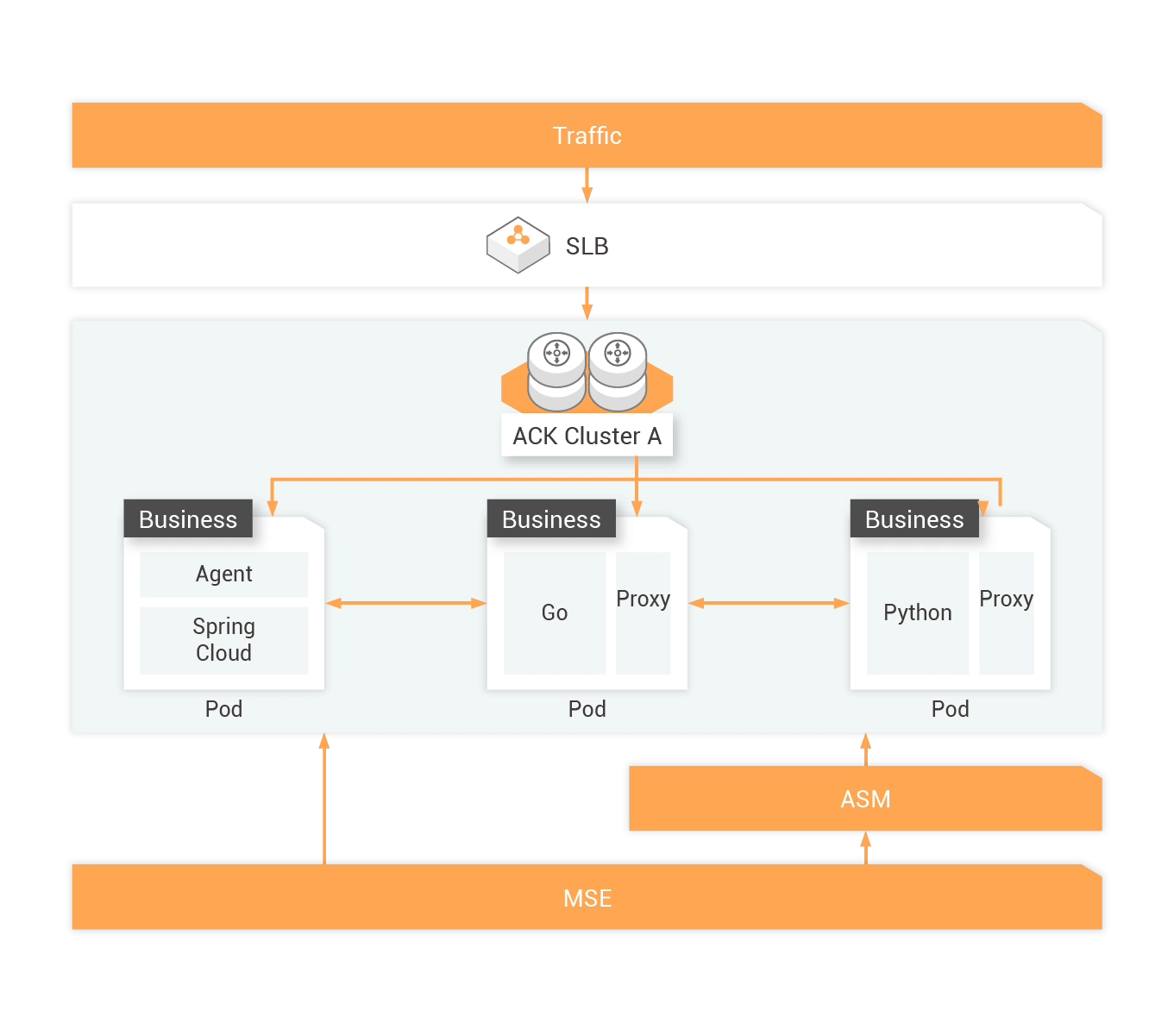One-stop Platform Compatible with Mainstream Open Source Microservices Ecosystems
Provides high-performance and highly available enterprise-level cloud service capabilities, such as service registration and discovery, configuration management, gateway connection, and service governance. The registration and configuration center is fully managed and compatible with Nacos, ZooKeeper, or Eureka. Gateways are built based on Istio and are compatible with the Kubernetes Ingress standard. MSE provides enhanced service governance based on open source microservices frameworks such as Spring Cloud and Apache Dubbo in a non-intrusive manner. MSE helps you use open source technologies to build your own microservices system with ease.
Enhancement Based on Open Source Capabilities
Fully compatible with open source community services and programming frameworks, and supports enhancement in stability, performance, observability, and ease of use.
Non-intrusive and Out-of-the-box
An application can be connected to microservices governance without modifying application code, configurations, and images. You can use the registration and configuration center after modifying the address of the cluster registry.
Fully Managed Service
Fully managed clusters are provided. You can focus on business development without resource purchase, deployment, and O&M. MSE is more professional, elastic, and reliable.
Cloud-native
Cloud-native gateways are built based on Istio and are compatible with the Kubernetes Ingress standard. Microservices governance implements traffic interconnection between the traditional Java framework and Istio.
High Availability
Managed instances have comprehensive health detection and automatic recovery capabilities, and a large number of availability pain points for open source middleware are overcome to ensure that engines can stably run for an extended period of time.
Visualization
Monitoring of various metrics and log analysis dashboards are provided for managed instances. The microservices governance feature visualizes the effects and makes services visible, manageable, and controllable.
Features
Governance Center
Enhances mainstream open source microservices frameworks such as Spring Cloud and Apache Dubbo in a non-intrusive manner, provides rich service governance features, and decouples middleware from business.
Canary Release
Supports observability, canary release, and rollback of applications. You can verify a new version of an application on a small number of instances, and then update the application on all instances if the verification is successful.
End-to-End Canary Release
Isolates the relevant version of an application into an independent runtime environment and routes request traffic to the destination version based on rules. This feature is configured online and takes effect in real time.
Graceful Publishing and Unpublishing
Provides features such as service prefetch, delayed publishing, and graceful unpublishing, and protects the entire process of service cold starts, scaling, and destruction to ensure business performance and continuity.
Outlier Instance Removal
Monitors the availability of provider application instances called by you and dynamically adjusts the instances to ensure successful service calls and improve the service stability and quality of service.
Service Authentication
Authenticates the traffic for calling applications and allows only applications that match the authentication rules to be called. This feature is configured online and takes effect in real time.
Cloud-native Gateway
Provides a more reliable, cost-effective, and efficient microservices API gateway that complies with the Kubernetes Ingress standard.
Service Governance
Provides various service governance capabilities, including multiple service discovery methods, such as using Kubernetes services and using Nacos as a registry, throttling and degradation, canary release, and route configuration.
Access Security
Supports certificate management, IP address blacklists and whitelists, JWT or OIDC authentication, and protection against WAF or DDoS attacks.
High Availability
Supports overload protection, graceful publishing and unpublishing, multi-zone disaster recovery, and auto scaling.
Observability
Allows you to view monitoring dashboards, query logs, view traces, and configure alert rules.
Registration and Configuration Center
The registration and configuration center is fully managed, compatible with Nacos, ZooKeeper, or Eureka, highly available, and supports comprehensive monitoring and alerting features, console O&M operations, and engine types. MSE Professional Edition is compatible with Nacos 2.0. Compared with MSE Basic Edition, MSE Professional Edition improves performance by about 10 times and has higher SLA compliance and configuration capabilities.
Fully Standard Use of Engines
Fully complies with the standard use of open source software. After you change the endpoint of an engine, you can use the engine without modifying the task code.
Data Management
Allows you to query and update data in a visualized manner, including adding, deleting, modifying, and querying data.
Monitoring and Alerting
Supports visualized engine monitoring and alerting for metrics such as the number of connections, TPS, and QPS, and multiple notification methods such as text messages, emails, and DingTalk chatbots.
Scenarios

The microservices architecture of business usually consists of two layers: traffic gateways and microservices gateways. The traffic gateways are responsible for north-south traffic scheduling and security protection, whereas the microservices gateways are responsible for east-west traffic scheduling and service governance. Cloud-native gateways change the two layers of gateways into one layer without compromising capabilities.
Benefits
-
Reduction of High Gateway Costs by 50%
Traffic gateways such as Kubernetes Ingresses and NGINX are combined with microservices gateways such as Spring Cloud gateways and Zuul gateways to save half of the resource costs and reduce O&M complexity.
-
Automatic Discovery and Governance of Microservices
Container clusters are integrated with microservices registries to implement automatic service discovery and route forwarding with ease. Features such as timeout retries, circuit breaking, and canary release are supported.
-
Better Performance than Traditional Microservices Gateways
Built based on Envoy and Istio, cloud-native gateways have better performance than traditional microservices gateways, and enhance the availability of backend services by using load balancing and traffic control capabilities to ensure that the business system smoothly responds to traffic peaks.

Diverse governance methods and traffic control of the microservice architecture not only take effect in the east-west direction between services, but also need to start from the north-south traffic of the ingress. Cloud-native gateways implement the affinity of microservices and are closely related to the microservice governance system.
Benefits
-
Canary Release
When you update a microservice, a canary release policy takes effect on gateways in addition to east-west traffic in the microservice environment. Canary traffic starts to be transmitted from the ingress of the portal.
-
Graceful Publishing and Unpublishing
Graceful publishing and unpublishing for Dubbo and Spring Cloud traffic are supported. When you release, scale in, or scale out an application, the traffic is smooth and lossless. In addition, components such as cloud-native gateways and messages are integrated. MSE automatically supports graceful publishing and unpublishing in the lifecycle of Kubernetes applications to automatically implement end-to-end lossless traffic during the release, publishing, and unpublishing of instances.
-
Outlier Instance Removal
When some instances in a server-side cluster are abnormally down, the consumer can actively determine the exception and remove corresponding provider instances for a short period of time. The consumer does not send requests to the instances until a specific period of time elapses. The consumer also can determine global exceptions. This effectively improves the overall availability of services.

As a BaaS-based service that can be used in the big data and microservice fields, MSE provides O&M-free and highly available engine services, a fully managed registration and configuration center compatible with Nacos, ZooKeeper, or Eureka, gateways compatible with the Kubernetes Ingress standard or Envoy, and non-intrusive and enhanced service governance based on open source capabilities.
Benefits
-
Distributed Coordination
If an enterprise uses open source software such as HBase, Spark, or Kafka, ZooKeeper, Eureka, and Nacos registries provided by MSE can be used to coordinate distributed systems.
-
Service Discovery
In the fast-growing cloud computing era, microservice-oriented applications are increasingly widely used. MSE provides a highly available, O&M-free, and stable service registry for microservices developed by using Apache Dubbo and Spring Cloud.

Security protection is a requirement for gateways. Cloud-native gateways support certificates used for HTTPS, IP address blacklists, and multiple authentication and authorization methods, and manage the security settings of APIs and services in a centralized manner to reduce your security access costs.
Benefits
-
Diverse Authentication Requirements
Provides conventional JWT authentication and OAuth 2.0-based OIDC authentication. You can flexibly configure authentication.

Service mesh technology provides strong support for multi-language applications to implement microservices governance capabilities similar to those of the traditional Java framework. Decoupling of a service mesh from business is applied to the traditional Java framework to help fast integration of the business and reduce transformation costs.
Benefits
-
Non-intrusive Connection
Allows you to connect to Dubbo and Spring Cloud microservice-oriented applications by using Java agents, and connect to applications developed in other languages by using sidecars without modifying application code.
-
Centralized Traffic Control and Configuration
Provides a set of configuration and governance policies to implement traffic control and governance of the traditional Java microservices framework and Istio. This reduces usage and maintenance costs.
-
Cross Language Interoperability
Implements traffic interconnection between the traditional Java framework and Istio.
Specifications
MSE Cloud-native Gateways
Compatible with the Kubernetes Ingress standard and supports multiple service discovery methods such as using ACK and Nacos.
Features
-
Combines Kubernetes Ingresses with microservices gateway.
-
Reduces resource costs by 50%.
Billing
Supports the pay-as-you-go and subscription billing methods. You are charged based on the engine specifications and the number of nodes.
MSE Registration and Configuration Center
Provides a one-stop microservice platform compatible with mainstream open source microservice ecosystems in the industry.
Features
-
Supports Nacos 2.0 and improves performance by about 10 times.
-
Provides service availability of 99.95% and more secure configurations.
Billing
Supports the pay-as-you-go and subscription billing methods. You are charged based on the engine specifications and the number of nodes.
MSE Microservices Governance
Implements production-level service governance in a non-intrusive manner, eliminates release risks, improves online stability, and protects application security.
Features
-
Provides native support for Spring Cloud and Apache Dubbo.
-
Provides a wide range of service governance capabilities, such as end-to-end canary release, and graceful publishing and unpublishing.
Billing
Supports only the pay-as-you-go billing method. You are charged based on the number of application nodes connected to the governance center.


 Combines Kubernetes Ingresses with microservices gateway.
Combines Kubernetes Ingresses with microservices gateway.


